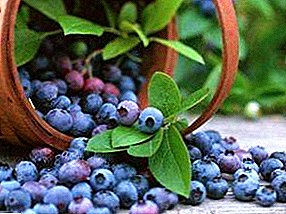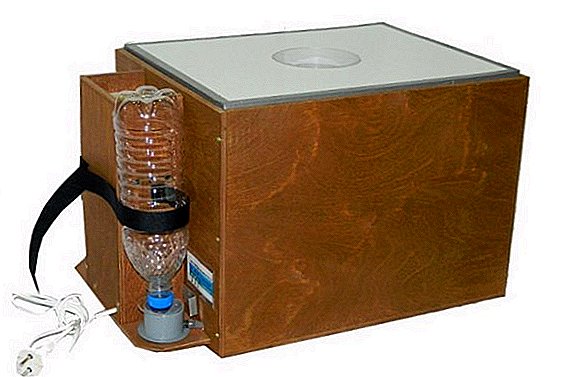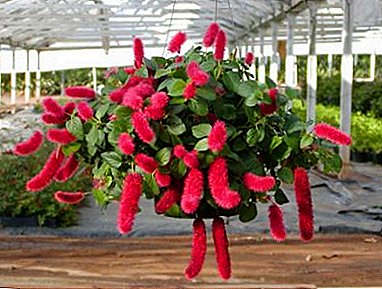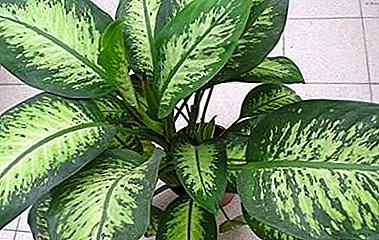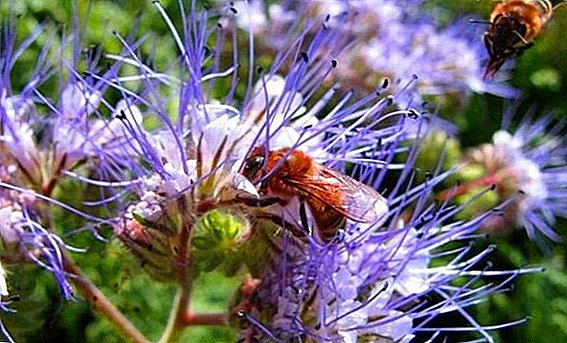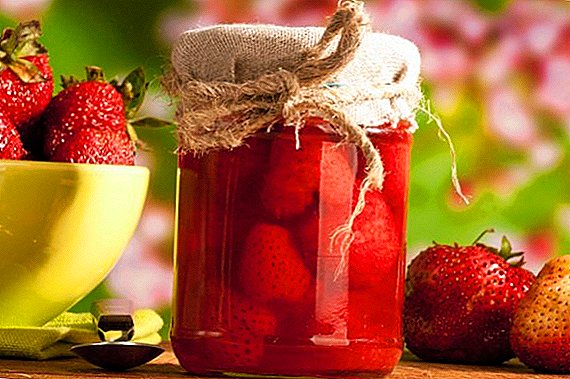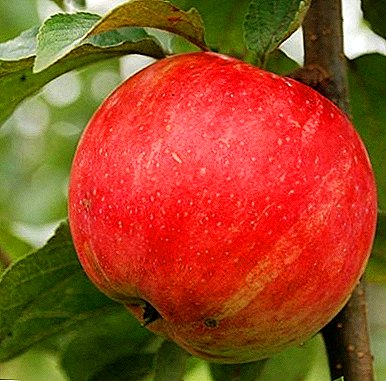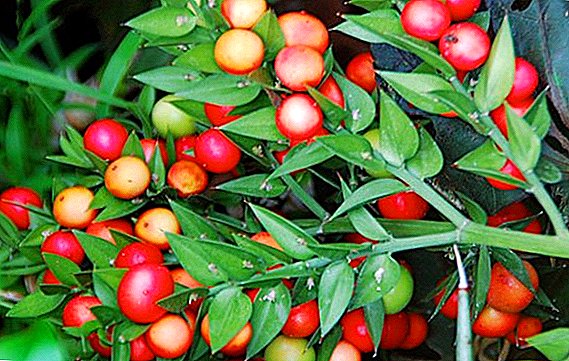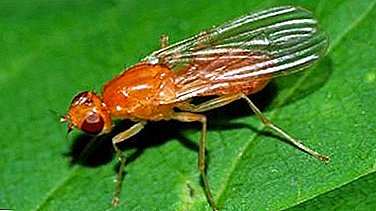
Carrot fly can destroy a significant part of the crop. After defeat by this insect the vegetable becomes unsuitable for storage and the use. But there are effective methods that will help protect carrots from pests.
Further in the article we describe the appearance of the pest and describe the damage it causes to carrots. There will also be given effective ways to combat carrot fly, which will help gardeners to protect their crops.
Description of the insect and its harm
 This is a member of the Psilidae family. The size of the insect is 4-4.5 mm. A fly can be recognized by the black color of the abdomen and thoracic, red head and yellow paws. The wings are transparent, have an oblong shape and brown streaks.
This is a member of the Psilidae family. The size of the insect is 4-4.5 mm. A fly can be recognized by the black color of the abdomen and thoracic, red head and yellow paws. The wings are transparent, have an oblong shape and brown streaks.
Harm carrots cause larvae. Their length reaches 5 mm. Color is light yellow. Larvae look like worms. Paws and heads are missing. Recognize carrots affected by insects by several signs of illness.:
- The leaves turn purple and then turn yellow and dry.
- The moves made by the larvae appear on the root neck.
- Root crop is covered with tubercles. From him begins to emit an unpleasant smell.
Causes of infection
- Carrot fly appears due to:
- thickening landings;
- too much watering;
- high humidity.
- Infection occurs as a result of non-compliance with crop rotation and location near the culture of diseased plants.
- The factors provoking the emergence of a pest include a lack of sunlight and the lack of necessary soil preparation during the autumn period.
Seasonal and temperature factors
 The fly makes two clutches during the season.: in May and at the end of July or August. Eggs it places on carrots root necks:
The fly makes two clutches during the season.: in May and at the end of July or August. Eggs it places on carrots root necks:
- In warm weather (+ 20-24 20С) the new generation will hatch in 5-7 days.
- If cold weather comes, this process will take about two weeks.
The larvae immediately begin to feed on the root.
After 3 weeks the larvae climb into the ground at a depth of 10-20 cmto turn into pupae.
How to save seedlings than watering or processing - step by step instructions
The pest is fought by scaring and destruction.
Scaring before and after thinning
Scare off the pest in various ways.
Use of tobacco dust
 Tobacco dust contains 1% nicotine.. This component helps ward off a fly. The area where carrots grow is sprinkled with a mixture of 30 g of dust and 1 liter of sand.
Tobacco dust contains 1% nicotine.. This component helps ward off a fly. The area where carrots grow is sprinkled with a mixture of 30 g of dust and 1 liter of sand.
Pre-thinning is necessary. This will help to mix tobacco dust well with the soil.
Sowing near other crops
 Before thinning the seedlings next to the carrots, garlic or onions are planted. The fly does not tolerate the peculiar smell emanating from these cultures.
Before thinning the seedlings next to the carrots, garlic or onions are planted. The fly does not tolerate the peculiar smell emanating from these cultures.
It is necessary to take into account that do not combine garlic with onions in the same bed. You need to choose one culture.
Naphthalene

- Plastic bottles make small holes.
- Then they put 1 naphthalene tablet in each and twist the caps.
- Bottles laid out between the rows of carrots.
When heated in the sun, naphthalene will emit a strong smell.which will not allow the fly to get close to the plants.
How to spray infusion of tomato tops?
 Tomato leaf possesses fungicidal and insecticidal properties due to the presence of solanine in the composition of the poisonous substance.
Tomato leaf possesses fungicidal and insecticidal properties due to the presence of solanine in the composition of the poisonous substance.
- It is poured boiling water at the rate of 1 l per 2 kg.
- Cool, filter and dilute with water in the ratio 1: 5.
For infusion suitable and dry tops:
- 1 kg of greens is crushed, pour 10 liters of water and insist 4-5 hours;
- then boil for 2-3 hours on low heat;
- when the infusion has cooled, it must be drained and diluted in water 1: 2.
Watering onion infusion

- 200 g of onion peel pour 2.5 liters of hot boiled water;
- insist for 2 days, then filter.
Spraying is carried out when 2-3 leaves are formed at the seedlings. Husk can be spread out between the rows..
Overview of means to help get rid of the insect
Chemical and biological preparations will help to destroy the carrot fly. Equally effective are folk remedies.
Folk
Popular methods involve the use of available funds in the fight against pest.that will be found in every gardener.
Garlic or onion

- For this infusion you need 300 g of garlic or onion, which you need to chop and pour 2 liters of boiling water.
- After two days, the tool is filtered and topped up with water to a volume of 10 liters.
- Also add 30 ml of liquid soap, so that the infusion adheres well to the plants and sprays.
Salt
 From 1 tbsp. l salt and 10 liters of water prepare a solution, which is processed planting carrots in early June.
From 1 tbsp. l salt and 10 liters of water prepare a solution, which is processed planting carrots in early June.
After 10 days, re-spray. Salt takes fluid from the body of the insect, which leads to its death.
A mixture of ash, tobacco and pepper

- Mix wood ash (50 g), tobacco dust (100 g) and chopped fresh pepper (100 g).
- The mixture is applied to the soil between the rows. For 1 m² will need 10 g of funds.
Carrots are treated twice with a break of 10 days.
Burdock and soap solution
 To prepare the solution will need 2 kg of burdock:
To prepare the solution will need 2 kg of burdock:
- It is crushed, poured 10 liters of water and put on fire.
- When the liquid boils, add 10 g of rubbed soap.
- The solution is removed from heat and incubated for a week.
Tomato decoction

- The tops in the amount of 4 kg boil for 5 hours in 1 liter of water.
- Filter the solution, add 50 g of soap and pour 3 liters of water.
Ready decoction spray culture.
Wormwood remedy
 Prepare an infusion of 300 g wormwood and 10 liters of boiling water.
Prepare an infusion of 300 g wormwood and 10 liters of boiling water.
It is possible to water carrots in 30 minutes. The infusion should cool to 25 ° C..
If necessary, wormwood can be diluted with cold water.
Shopkeepers
In stores you can find a wide selection of tools that will help get rid of the pest.
Fitoderm
 The drug is diluted in water in a proportion of 10 ml per 5 liters. The ground solution is sprayed with the prepared solution, using 5 liters per 10 m². Floterm is dangerous for bees, so it can not be used during the flowering period..
The drug is diluted in water in a proportion of 10 ml per 5 liters. The ground solution is sprayed with the prepared solution, using 5 liters per 10 m². Floterm is dangerous for bees, so it can not be used during the flowering period..
When working with the drug is necessary to use special clothes, glasses and gloves. In case of contact with the skin, the affected areas should be washed with water.
Arrivo
 The insecticide is added to water (1.5 ml per 10 l) and the plants are sprayed twice. Processing is prohibited in hot and rainy weather..
The insecticide is added to water (1.5 ml per 10 l) and the plants are sprayed twice. Processing is prohibited in hot and rainy weather..
To work should choose the morning or evening.
Decis
 Carrots are treated with a solution of 3 g of the drug and 1 l of water. Consumption rate - 10 liters per 100 m². Decis is not stored in the ground, it is safe for people and animals.
Carrots are treated with a solution of 3 g of the drug and 1 l of water. Consumption rate - 10 liters per 100 m². Decis is not stored in the ground, it is safe for people and animals.
Available in the form of tablets, granules and emulsion.
Aktara
 The drug is sold in ampoules of 9 and 1.2 ml, as well as in granules of 4 g. It is diluted in warm water at a temperature of 25 ° C (8 g per 10 l), spraying consumption - 10 l per 10 m².
The drug is sold in ampoules of 9 and 1.2 ml, as well as in granules of 4 g. It is diluted in warm water at a temperature of 25 ° C (8 g per 10 l), spraying consumption - 10 l per 10 m².
The solution can be used during precipitation.
Actellic
 A 2 ml ampoule is dissolved in 2 l of water. Plants sprayed in dry weather at + 10- + 25˚С. For 10 m² used in 2 liters of mortar.
A 2 ml ampoule is dissolved in 2 l of water. Plants sprayed in dry weather at + 10- + 25˚С. For 10 m² used in 2 liters of mortar.
Carrots are treated no later than 3 weeks before harvest.
Biological
Biological agents are a safe alternative to chemical processing.. Substances in their composition, do not accumulate in the tissues of plants, soil, humans and animals. But for the destruction of pests takes more time than using chemicals.
- Dachnik drug diluted in 1.5 ml per 1 liter of water. Conduct two sprays with a period of 10 days.
- Actofit is added to warm water (10 ml per 10 l). Carrot and soil are treated with a solution, 5 liters are used for 10 m².
Special protective structures
The design must be installed in the first half of May.. Along the perimeter of the plot, a fence of wooden or metal stakes and a breathable material is constructed. Its height should reach 1 m. Carrot flies do not rise above 80 cm, so they will not be able to overcome such a fence.
How to protect with lutrasil or spunbond?
These covering materials will protect carrots from insect infiltration from the air. If the soil is already infected with pests, their use will not be effective.
The material is attached to the arc, which is installed on the bed when the germs. Spunbond and lutrasil pass water, so during the irrigation they can not be removed.
Shelter dismantled only when weeding, and when the plants reach the level of the roof.
How can you save your garden in the future?
To protect the beds should use the following methods.
Special care measures

- In the autumn you need to dig the soil by 20 cm. This will help to destroy the pests in the soil.
- Landing is carried out on a sunny plot, located on a small elevation.
- Need to adhere to crop rotation. Carrots are planted after sideratov, potatoes, cabbage, zucchini, pumpkin, cucumbers, garlic or onions. At the same place culture can be grown after 3 years.
- Next to the vegetable you need to plant onions or garlic to repel insects.
- Over-watering should be avoided. Carrots are moistened once a week.
- You can not feed the culture with manure, because it may be the larvae of the fly.
- Do not allow thickened landings. Carrots thinned at least 3 times during growth. The beds are mulched with peat.
Treatment with special preparations
- To destroy the larvae in the soil used:
- Fly-eater (50 g per 1 m²);
- Basudin (30 g per 20 m²);
- Provotoks (4 g per 1 m²).
- The culture is sprayed with a solution of Actophyte (10 ml per 5 l of water).
- During the growing season, the plant is treated with Inta-Vir (1 tablet per 1 l).
Trap application
You can make traps in different ways. One of them is the use of plastic bottles:
- At the tank, the upper part is cut off and turned over so that the neck is at the bottom.
- Then inserted into the bottle and poured bread kvass.
Insects will react to smell and fall into the trap.
The bait can be made from pieces of paper or fabric. The material is smeared with a mixture of equal parts of castor oil, honey and rosin, and then laid out on the beds.
List of Pest Resistant Varieties
Carrots with absolute resistance to carrots no. But there are varieties that are least susceptible to the attack of these pests. It:

- Calgary F1.
- Olympus.
- Nantes 4.
- Shantane.
- Amsterdam.
- The cardinal
- Maestro F1.
- Flyway F1.
- Nantik Resistaflay F1.
- Perfection
- Vitamin 5.
- Flakke.
- Incomparable.
- Losinoostrovskaya.
These varieties have a low content of chlorogenic acid, which attracts insects.
To prevent the appearance of carrot flies, it is necessary to grow carrots in accordance with agrotechnical requirements. If the culture is already affected by insects, folk and store supplies will help get rid of them. When choosing a variety, preference should be given to carrots that are not of interest to the pest.


